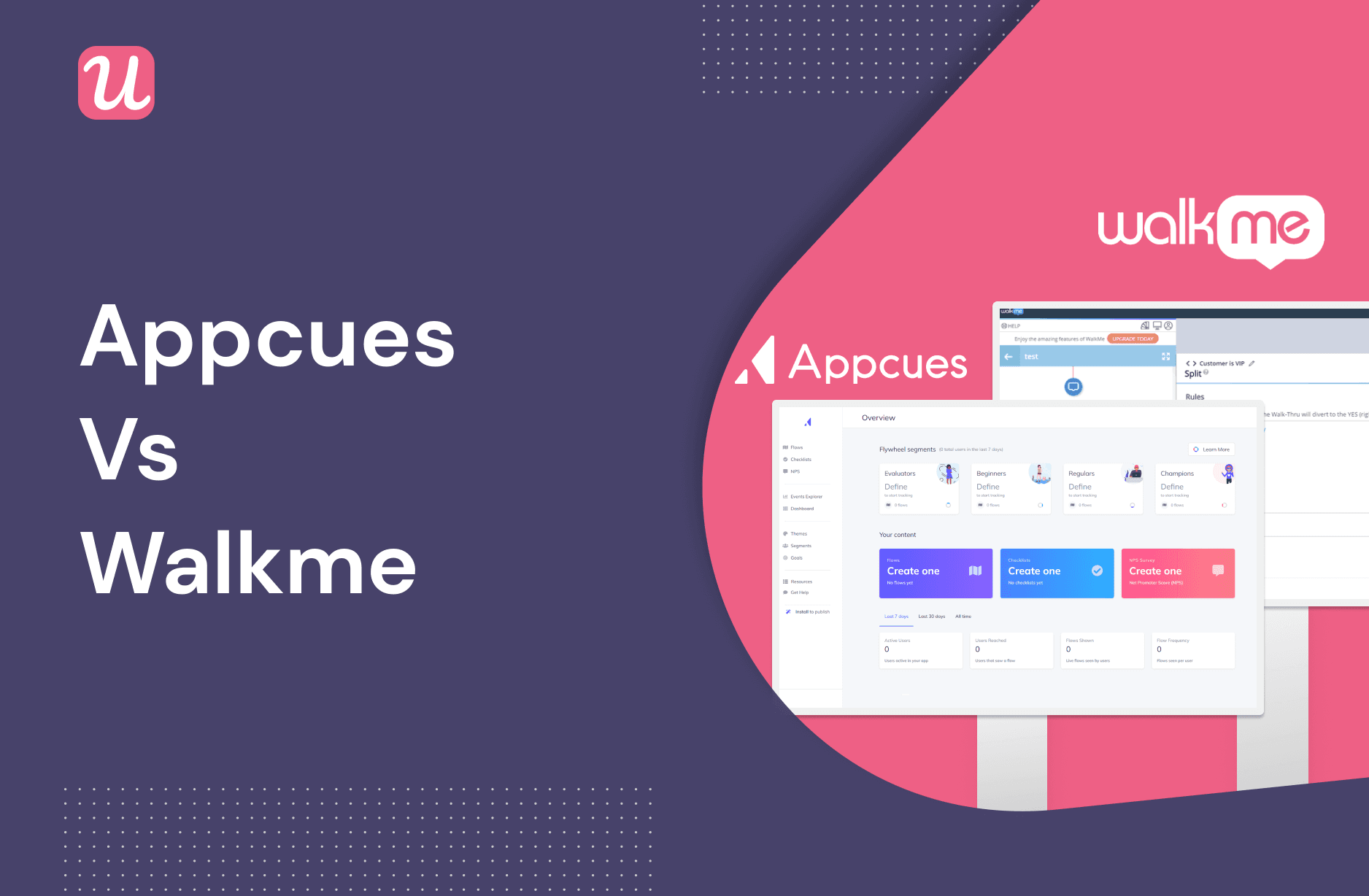Appcues vs. WalkMe: Which is Better for Your Product Adoption Strategy?

Why is product adoption important for SaaS?
Product adoption rates can literally make or break a SaaS company. You can acquire new users all day long, but if none of them convert into loyal, paying customers then you’re not going to see any profits.
So let’s take a look at what exactly makes product adoption such a critical part of SaaS success.
Reason #1 – Churn
Users churn (ie. cancel their subscription) when they don’t find value in your product. This may not happen because your product is bad, but rather because the user can’t find or understand the feature that they need.
Thus, one of the most powerful ways to reduce churn is to teach your users how to make effective use of your product. Tools like WalkMe and Appcues help you achieve this by building interactive walkthroughs.
Walkthroughs that are interactive are much more effective than traditional linear product tours because they let the user “learn by doing”. This way of helping users discover a feature through use rather than lecture avoids information overload and users skipping through the tour entirely.

The point of a product tour is to decrease friction in the user experience, not add to it! Interactive walkthroughs get your users to the “AHA moment” quickly and unobtrusively, decreasing the chance that they’ll get frustrated and churn.
Reason #2 – Customer Expansion
When users more fully “adopt” your product, it means they’re coming to value it as a solution. This significantly increases the likelihood that they’ll be interested in letting the product do even more for them.
This is where customer expansion strategies come in. The three main types are:
- Upselling: Customers upgrade from a free to a paid subscription or a paid to a premium subscription.
- Cross-selling: Expands a customer’s subscription by offering a separate but related product from your company.
- Add-ons: These are additional features that a customer can pay to have added into their current subscription to your product.
Effective product adoption makes all three of these customer expansion strategies easier. The more value a customer gets from your product, the more motivated they’ll be to “expand” that value.

Plus, it supports your bottom line. After all, upselling to existing customers can be 5 to 10 times cheaper than acquiring new customers.
Reason #3 – User Activation
Converting free trial users to paying customers can be tricky. It’s great if your free trial is popular, but if nobody sticks with it and upgrades, you’re not going to make any money.
Product adoption is all about nudging users forward in the user journey. A user might hit the “AHA moment” with a free trial, but still needs to experience that value rather than just perceive it before they’ll decide to fork over money for a subscription.

Luckily, strong user onboarding strategies like interactive walkthroughs can make a huge difference here. Skeptical? Here’s an example of good product adoption in action: Albacross set up a new user onboarding flow with Userpilot and in two weeks they’d increased their user activation rate, user adoption, and trial to paid conversions more than 33%!
Pretty impressive!
Now that we know why product adoption is so important, let’s look more in-depth at the digital adoption tools themselves.
The good and bad sides of Appcues
Appcues is a popular and well-established user onboarding and digital adoption platform. Their software focuses on first-party product adoption and is designed to be easy to set up and implement even for non-technical users. The no-code Builder makes UI design simple, and they offer a range of UI patterns for integrating checklists, in app messages, modals, and tooltips.

In addition to building user onboarding flows, Appcues also allows you to segment users to create custom experiences and track product usage analytics. This means that you can set up dynamic user onboarding experiences and then track user behavior so that you can optimize the experience further.
All this makes Appcues an effective, user-friendly platform for implementing onboarding and feature adoption strategies in your product. And while it does offer many must-have features for product adoption, it’s not a perfect solution for everybody.
Let’s dig into some of the pros and cons of using Appcues.
The pros of Appcues
One of Appcues’ distinguishing characteristics is its ease-of-use. It comes pre-loaded with information, UI patterns, and templates which make setting up user onboarding flows a breeze.
This is great for users who are new to customer onboarding and don’t care about doing a lot of customization and creating really bespoke flows for complex use cases.
But for more advanced users, the templates and pre-defined UI patterns can be limiting compared to other code-free product adoption tools like Userpilot.

Nevertheless, the tools and features you get with Appcues are powerful and could be just what you need to get up and running with user onboarding. Here are some of the highlights of what Appcues offers:
1. Two-way integration with Salesforce and Hubspot with premium plans
This is a huge benefit for larger, enterprise-level companies. Of course, it requires a premium plan, but if your company is large enough to need Salesforce and Hubspot, then the price tag might make sense for the ability to create a seamless user experience across software channels.
2. Clean UI and Easy UX
Using Appcues is easy, straightforward, and intuitive. Creating an interactive product walkthrough complete with checklists and tooltips may seem intimidating, but they’ve managed to make the process just about as painless as possible.
3. Robust tools for tracking the user journey and experiences
Appcues lets you segment users and even provides some pre-defined user segments to get you off and running. This is critical to getting the most out of your product usage analytics, which Appcues makes simple to view and assess.
The cons of Appcues
The cons we’ll discuss here are mostly dependent on which Appcues pricing tier you get. In a nutshell, the lowest plan is quite limited, and to get more of the features you might need means spending a lot of money.
1. Limited features in the lowest plan
Appcues’ basic plan lets you create solid product walkthroughs, but they’re going to look and behave just like every other basic Appcues walkthrough that’s ever been created.
But styling to match your UI requires CSS and proper segmentation requires an upgrade to the Growth Plan (at a cost of $10,500 upfront!).
This makes it somewhat less than code-free, unlike alternatives like Userpilot that let you customize every aspect of your design without writing any code.
2. Expensive
The $249 per month basic plan gets you 5 user segments, 10 custom events, and 10 feature tags. This might work for a startup’s first-ever user onboarding flow, but it doesn’t leave much room to grow.
The next pricing tier makes access to many of these features unlimited but costs $879 per month. However, you actually have to pay that annually, and so it comes to more than $10,500 upfront for a tool that’ll have any capacity for growth. That’s super steep, especially compared to alternatives like Userpilot where access to unlimited custom events and segments are part of the basic pricing plan ($249 per month).
3. No resource center
Resource centers are the backbone of effective self-serve onboarding. Offering a place in-app where users can go to get answers and trigger relevant walkthroughs reduces friction and allows users more opportunity to “learn by doing”.

So it’s surprising that Appcues doesn’t offer this kind of feature, which comes even with the basic plan of a competitor like Userpilot.
The good and bad of WalkMe
WalkMe is another of the big names in digital adoption platforms. While Appcues bills itself as a scalable mid-market onboarding solution, WalkMe focuses on employee onboarding for enterprise-level companies.

That said, many of the tools and features they offer overlap. Just like Appcues, WalkMe software lets you create dynamic, interactive walkthroughs with a suite of features such as onboarding checklists, modals, and tooltips.
To see more clearly how the two tools differ, let’s take a look at the pros and cons of WalkMe.
The pros of WalkMe
WalkMe is known for its robust, customizable product walkthroughs. One of the biggest differences from Appcues, though, is that WalkMe can be used with 3rd party tools whereas Appcues is designed for 1st party.
This makes sense given that WalkMe’s main use case is employee onboarding. So that should be taken into consideration when evaluating whether its pros and cons are directly applicable to your situation.
1. Good for employee onboarding on 3rd party tools
If you’re a large company with an IT department swamped in service tickets, WalkMe may have the solution for you. Its walkthroughs can be implemented on the software tools your employees use so that they get interactive training as they use the tool.
2. Supports sophisticated design and behavior customization
WalkMe is extremely customizable both in its design and the walkthrough experiences you can create. However, high-level customization of WalkMe features is only available if you have a fair amount of coding and technical expertise.
WalkMe does offer a code-free Editor application, but like Appcues, using their creation tool limits the amount of customization you can do.
3. Strong scaling for employee onboarding
WalkMe is aimed at large enterprises and so they’ve made sure their product is scalable. In fact, 30% of Fortune 500 companies use WalkMe, so it’s clear they know how to support big, complex organizations.
The cons of Walkme
WalkMe is an extremely powerful tool, but it’s not without downsides. Unlike Appcues, it’s not well-known for being easy to use. But let’s take a look at some of the details:
1. Very outdated UX and UI
The WalkMe Editor is known for being rather clunky and unresponsive. Whereas code-free tools like Appcues and Userpilot make walkthrough creation sleek and efficient, using WalkMe can be confusing and requires a significant amount of training.
2. Development-heavy integrations
WakMe isn’t easy to implement. While some WalkMe competitors like Userpilot can be set up in minutes, WalkMe itself generally takes weeks or months to set up.
In fact, installing WalkMe can be so complex that many users have reported needing a full-time technical expert just to set up and maintain it. WalkMe does offer certified experts to help, but you have to pay more for their assistance. Which leads to…
3. Extremely expensive
WalkMe doesn’t come cheaply. While it doesn’t publish pricing information directly, customer reviews indicate that its Basic plan (somewhat comparable in features to Appcues’ lowest tier) starts at $9,000 per year. Custom plans can be $20,000+ per year, not accounting for hiring out technical support just to get the software running.
In other words, WalkMe might work well for a large company with a big budget, but it’s not a great option for user onboarding or product adoption use cases in smaller SaaS companies.
Price comparison – Appcues vs Walkme
Improving product adoption is all about creating more value for your customers, and in turn generating more value for your company. So it’s important to consider how much the cost of a product adoption tool will eat into the potential profits.
Appcues pricing
In a nutshell, for $299 per month (or $249 per month if paid annually), you get a very basic and limited tool for creating simple, standardized product walkthroughs. Opening up the functionality means spending $879 per month.
But that higher tier plan has to be paid annually, so to get more than 10 walkthrough events or 3 team members, you’ll be paying more than $10,500 upfront.
So unless you’re a small company with no plans for growth, budget at least $10k for an Appcues account.
To get a clearer picture, here’s rundown of each of Appcues’ pricing tiers:
Essentials Plan
- $299/month or $249/month if paid annually
- Up to three teammate accounts on this plan
- Max of five user segments
- Up to 10 track events
- Limited number of integrations
Growth Plan
- $879/month paid annually
- Up to 10 teammates accounts on this plan
- Unlimited events
- Unlimited integrations
- Unlimited segments
- Dedicated customer success manager
Enterprise Plan
- Custom pricing
- All features from essentials and growth plans
- Multi-language localization support
- Enterprise account administration, including roles and permissions
- Premium support
WalkMe pricing
If Appcues seems expensive to you, then you may just want to skip this section. When comparing features, WalkMe’s Basic plan is even more limited than Appcues’, but reportedly costs about $9,000 per year. That’s nearly as much as the Appcues Growth Plan, but with hardly any of the features.
To get more than five walkthrough events and 300 “assists” (every time a user activates a walkthrough it counts as one assist) you’ve got to upgrade to a custom plan. This means paying at least double the Basic plan price, though users report that WalkMe pricing is based largely on the number of monthly active users you have.
So while most custom plans seem to start at around $20,000 per year, WalkMe only gets more expensive as your company grows (some users indicate their company pays as much as $50,000 per year). This is significantly more than Appcues or other WalkMe alternatives.

Appcues vs WalkMe: which should you choose?
Now that we’ve covered the pros, cons, and pricing of each tool, let’s review where each would make the best fit.
Appcues use cases
- Companies looking for SaaS customer onboarding for their own product.
- Large companies that can afford the $10,000 annual cost of the growth plan and don’t have a lot of technical expertise to spare for setup and implementation.
- Small companies that just want to experiment with product walkthroughs. The essentials plan is so limited that it is basically just a paid trial. If you plan for any amount of growth, the essential plan’s user segments and custom events just aren’t enough.
- Companies that need a lot of integrations. Appcues offers nearly 20 different integrations, including Salesforce, Hubspot, Marketo, Slack, Intercom, Heap, and Mixpanel among others.
WalkMe use cases
- Companies looking for employee onboarding with 3rd party tools.
- Enterprise-level companies that can afford the custom plan and want advanced API support.
- Companies that need a highly scalable onboarding tool and don’t mind paying a premium for it.
- Companies who want more communications and analytics-driven integrations, such as Amazon Web Services, Google Analytics, Slack, and Pure Chat among others.
The best option?
Ultimately the decision between Appcues and WalkMe comes down to your use case. Both are expensive, both offer customization at higher price tiers, and neither has a very useful basic plan. However, Appcues is going to work better for SaaS customer onboarding, while WalkMe is more effective for employee onboarding.
These aren’t the only two product adoption tools available, though. At just $249 per month, Userpilot offers a robust no-code product adoption platform that doesn’t limit the number of walkthroughs, events, or analytics. It’s highly customizable and doesn’t require all your IT resources or hiring an outside expert to code and implement.
If that sounds appealing and you’re looking to increase product adoption with in-app onboarding, go grab a Userpilot demo and get started today!

